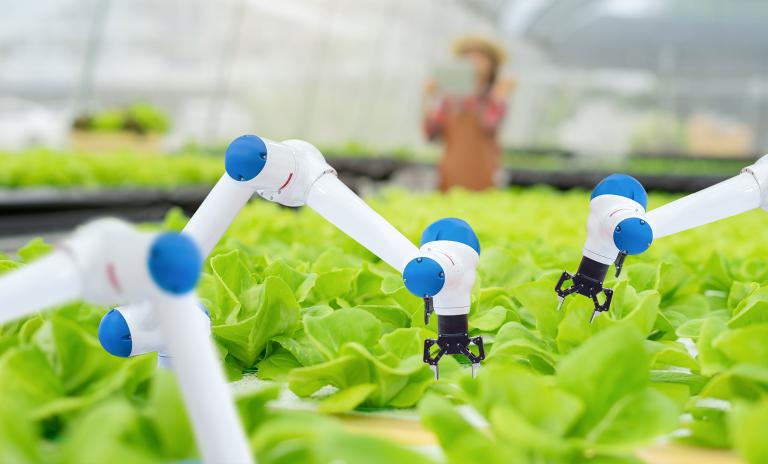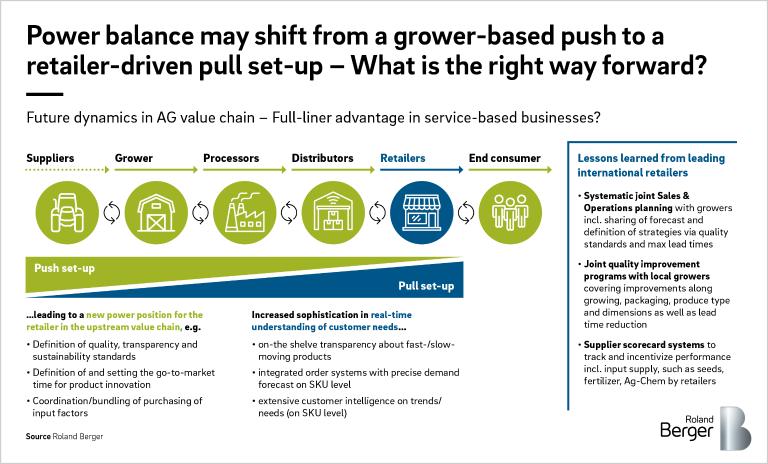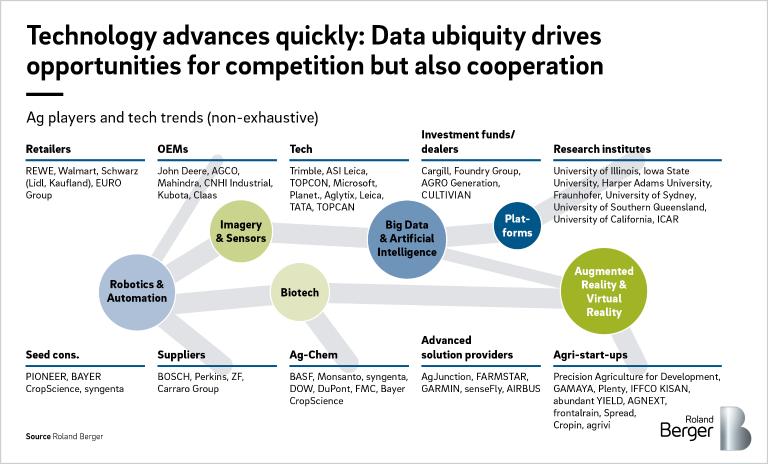Precision farming improves farmer livelihoods and ensures sustainable food production. This involves the interaction of different segments.


Precision farming
Precision agriculture: How farming data cultivates tomorrow’s table
Global warming, rising inflation, and limited resources are straining the global food supply. Here’s how automation and robotics can turn the tide, according to new Roland Berger research.
Like many industries, agriculture and food production face significant turmoil. Sustainability and climate change are front and center. This is because agricultural emissions and land use are major contributors of global warming. In drought-stricken areas such as California, Germany, and China, water consumption is another hot topic. All around the world, so is labor availability, global production increases, price inflation, and even the “weaponization” of food supplies by Russia.

To overcome these challenges, customers and growers must work together to change how we demand, consume, and supply tomorrow’s food . For example, beef, lamb, and pork consumption must be reduced in favor of emissions-friendly products such as chicken or vegetarian alternatives to satisfy growing demand while limiting our unsustainable environmental impacts. Since one third (or higher in developed markets) of the global food supply is wasted every year, we must rethink our logistics, consumer awareness, and composting to conserve more.
In our view, the current industry is ill-prepared to meet the demands of our threatened planet and growing population . But there is a way to ensure a healthier tomorrow.
"While the farming industry has done a remarkable job in recent decades to increase food access across the globe, given our current challenges, the industry must change again. In our view, precision agriculture is the answer."
Technology the enabler
As in other industries, technology is a key enabler to address these pressing agricultural challenges. But it’s important to understand that use cases vary widely across geographies, farm sizes, crop types, and practices. For instance, a commercial farmer in the US who grows corn, wheat, and soybeans may optimize crop inputs and yield predictions to manage tight margins and stabilize finances. Small-holders in China and India may struggle with basic farming practices such as mechanization to improve productivity.
Meanwhile, family-owned farmers in the Middle East will likely face a lack of market access, financing, and risk management tools such as crop insurance. And farmers in Europe with good market access and logistics might continue their reluctance to use technology to grow their business. In short, technology presents an Earth-saving opportunity around the ownership and use of information to work in both the farmer’s and greater society’s best interest. That is the promise of precision agriculture, which involves observing, measuring, and responding to crop variability and its inputs.
For example, the data that precision farming generates allows us to optimize production at the level of individual animals to realize higher yields, higher quality, and safer, more sustainable foods. It allows us to reuse waste streams in the value chain, which is a gain for both the planet and the food we consume. It can identify value-added products, like high-content protein powder derived from the waste of beer brewers, and integrate producers, processors, and retailers to create better transparency while reducing losses.
In short, the sum of all initiatives and opportunities that precision agriculture creates has the potential to revolutionize the way we produce and consume food, while increasing the health outcomes of people and the planet.
Automation and robotics
No two technologies are more important to precision agriculture than solutions than automation and robotics . For instance, in the vegetables and fruits domain, automation of pre-harvest, harvest assist, and post-harvest activities has a major impact on yield. This is especially pertinent as increasing inflation and regulation puts further pressure on grower input costs and administration.
Moving forward, we expect automation to redirect manual human labor towards more high-skill, technology related tasks. In a recent crop automation report by the Western Growers Association and Roland Berger, 50% of grower respondents indicated having employees dedicated to the integration of automation technology.
Notable progress has also been made in the commercialization of harvest automation. When comparing year-over-year survey data, automation start-ups have secured more funding, deployed more machines in the field, and increased paying customers. They have also helped to address labor availability issues. (Unfortunately, automation can’t solve all of the issues at once. Today’s strawberry production, for example, has shifted from Germany and France to Turkey, Poland, and select African countries for their cost advantages. But this can lead to higher logistics costs, which may offset any labor gains, while adding harmful emissions.)
Additionally, swarm bots and automated tractors such as John Deer’s 8R are being used for better soil preparation and more harvesting hours to increase production. As is the case in many technology applications, autonomous services are also available in new business models. For instance, farmers can subscribe to the autonomous function of the 8R in a per hectare subscription model. In the long run, subscription-based models could enable equipment manufacturers and their dealers to move into farming-as-a-service approaches. The latter would help protect margins in an environment where power is increasingly shifting towards large retailers.
In general, consistent data collection and analysis during the crop cycle from soil preparation to harvest enables improved efficiencies in the production process. Agricultural equipment manufacturers have started thinking about agricultural production not in terms of products such as tractors or combines but in terms of production systems for wheat, corn, soy, etc. Improving yields and reducing input materials improves farmer profitability. But when used correctly, precision agriculture can also reduce greenhouse gasses, water usage, logistic costs, and even vertical pig farms to reduce animal disease.

Looking ahead
Before they become mainstream, smart farming solutions have to be affordable, easy to adopt, and bring value to small farmers and commercial growers alike. Since it’s unlikely that solutions that are developed in the West will apply to small holder markets in China, India and Africa, governments in these regions will need to support innovations and local champions to drive sustainability. As such, we must find ways to enable innovation across all markets.
Similarly, helping companies to find their way in the maze and helping start-ups to understand market needs and scale are top priorities. Which is why Roland Berger recently collaborated with the Western Growers specialty crops automation initiative. Since many problems that farmers face require a concerted effort, interoperability, the capability of different systems from different manufacturers, and data integration are paramount. The bad news is these are very complex challenges.
The good news is that technology standards, capable partners, and specialized skill sets can alleviate some of the complexity. While the farming industry has done a remarkable job in recent decades to increase food access across the globe, given our current challenges, the industry must change again. In our view, precision agriculture is the answer. Thank you for reading and considering our decades of agricultural experience as you chart your future.





_tile_teaser_w425x260.jpg?v=770441)


